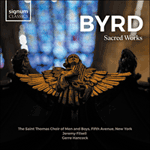
Welcome to Hyperion Records, a British classical label devoted to presenting high-quality recordings of music of all styles and from all periods from the twelfth century to the twenty-first.
Hyperion offers both CDs, and downloads in a number of formats. The site is also available in several languages.
Please use the dropdown buttons to set your preferred options, or use the checkbox to accept the defaults.

| Jeremy Filsell (organ)» More |
The first setting starts off in two voices, and adds just one part in running quavers below the right hand’s plainsong semibreves; a third voice joins in as the music breaks into triple rhythms. This piece contains a 3-bar quotation (bars 42 to 44) from a Gloria tibi trinitas setting by one of the Chapel royal organists, John Blitheman. Even though Byrd chose not to follow his path stylistically as a composer, they were later to become colleagues for twenty years and presumably had a good professional relationship.
The second setting, in three voices, places the chant an octave lower (where it has to be played mostly by the thumb of the left hand). The quaver counterpoint is above, now, and a new one in minims is added, below. These soon change places, the minims give way to crotchets, the rhythm speeds up, and finally hints of a fourth voice are heard as the music heads for its cadence with considerable assurance.
from notes by Davitt Moroney © 1999
Le premier verset commence à deux voix, avec une main gauche en croches rapides, en dessous du plain-chant qui est en semi-brèves à la main droite ; une troisième voix s’ajoute à la texture, au moment où la musique passe en triolets. Byrd y incorpore une citation (mesures 42-44) d’un Gloria tibi trinitas de Blitheman. Bien que Byrd ait choisi de ne pas suivre le chemin stylistique de celui-ci, ils sont devenus néanmoins collègues plus tard, pendant vingts ans, et avaient sans doute de bonnes relations professionnelles.
Le second verset, à trois voix, présente le plain-chant une octave plus bas (où il doit être joué par le pouce de la main gauche). Le contrepoint en croches se trouve maintenant au-dessus, et une autre partie est ajoutée en blanches, plus haut. Mais la texture est bientôt renversée, et les deux lignes changent de place ; ensuite les blanches cèdent la place aux noires, le rhythme s’accélère, et à la fin une quatrième voix arrive pour amener la musique vers une cadence affirmée.
extrait des notes rédigées par Davitt Moroney © 1999
 Byrd: Sacred Works Byrd: Sacred WorksThis fine set offers an opportunity to experience the rich liturgy of Saint Thomas Fifth Avenue, a showcase for the music of William Byrd, and the welcome unearthing of a pioneering recording of The Great Service from 1981 and not previously avail ...» More |

